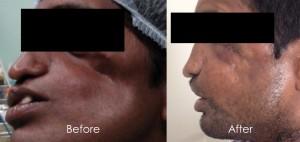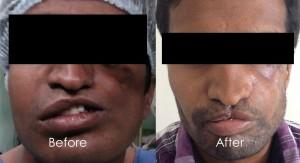In many societies (barring possibly societies in which women are veiled), your face is your passport to everyday interactions with others and, as such, features prominently in the creation of self-identity. The very fact that a disastrous fall in society is referred to as “losing face” is indicative of the importance of that presentation to the world. The difficulties confronted (or faced) by those who have facial deformations, whether from birth defects, post surgery transformations, or through accident, was poignantly addressed by the author Lucy Grealy in her book Autobiography of a Face. The tragic impact of what she saw (and what others all too often pointed out) as a crippling physical deformity, the result of removing her jaw bone as part of treatment for a rare form of cancer, that would never allow her complete integration into society was bound up in the addiction to oxycontin pain killers and her later death from an overdose of heroin.
There are a great number of surgeons and practices dedicated to the restoration of “face” through maxiofacial and microvascular surgeries. Those types of practices are finding that 3D printing provides a particularly useful tool for enhancing the outcomes of the surgery. For those who need surgical reconstruction for their faces, it is not always possible for the surgery to occur immediately after the deformation is inflicted (in conjunction with the removal of a tumor, for example). When surgery is able to be performed immediately, it is called primary reconstruction. If a space of time separates the initial event and the surgical reconstruction, it is known as secondary reconstruction.
 Dr. Vishal Rao, a head and neck surgeon, recently treated a patient, identified only as “Mr. A,” during a secondary reconstruction procedure. Several years prior, Mr. A underwent surgery to remove a malignant tumor located in his left upper jaw. Unfortunately, because of a failure to properly explain the reconstructive procedure, he declined undergoing reconstructive surgery at the same time as the cancer removal procedure.
Dr. Vishal Rao, a head and neck surgeon, recently treated a patient, identified only as “Mr. A,” during a secondary reconstruction procedure. Several years prior, Mr. A underwent surgery to remove a malignant tumor located in his left upper jaw. Unfortunately, because of a failure to properly explain the reconstructive procedure, he declined undergoing reconstructive surgery at the same time as the cancer removal procedure.
When Mr. A decided to undergo facial reconstruction it was due to extreme loss of self-esteem, an inability to integrate into society, difficulties breathing and swallowing, and negative impact on his vision. The surgery necessary for his benefit is known as microvascular reconstruction and is a complex and challenging area. In order to prepare for the surgery, a 3D printed medical model of his skeletal topography was created by Bangalore, India-based Osteo3D. This allowed the surgeons to more accurately assess the defect present in the upper jaw and therefore to be better prepared for approaching the procedure itself.
 The model was also enormously helpful during the procedure. One of the greatest challenges in performing this type of surgery is that of the lost elasticity due to fibrosis resulting from previous surgery and radiation. In addition, it is a difficult area to work in as the blood vessels may not be sufficiently long to, once cut, be reconnected to the neck for joining. In order to reduce the risk to the patient, the 3D model was brought in to the operating theater and used as a dummy to measure the fit of the bone segments to be shaped to fit into the cavities left when the bone was removed during the initial cancer treatment. Osteo3D explained the support provided by the model:
The model was also enormously helpful during the procedure. One of the greatest challenges in performing this type of surgery is that of the lost elasticity due to fibrosis resulting from previous surgery and radiation. In addition, it is a difficult area to work in as the blood vessels may not be sufficiently long to, once cut, be reconnected to the neck for joining. In order to reduce the risk to the patient, the 3D model was brought in to the operating theater and used as a dummy to measure the fit of the bone segments to be shaped to fit into the cavities left when the bone was removed during the initial cancer treatment. Osteo3D explained the support provided by the model:
“All this was pre-fabricated and checked on the 3D printed medical model before cutting the blood vessels of the fibula flap. This reduced the ischemia time (time during which the flap will be without the blood supply until it is fixed to the lost area and blood vessels are joined in the neck to restart the blood flow). The lesser the ischemia time the better is the outcome. 3D printed medical model for surgical planning increases accuracy for the reconstruction and reduces the ischemia time to a great extent.”
 This is yet another example of the ways in which 3D printing is not just being used to create beautiful objects or mass customized baubles, but also becoming an integral part of improving health care outcomes. Mr. A was feeling much better about himself during his follow up visit with the surgical team and reported that his speech and eating problems had greatly improved.
This is yet another example of the ways in which 3D printing is not just being used to create beautiful objects or mass customized baubles, but also becoming an integral part of improving health care outcomes. Mr. A was feeling much better about himself during his follow up visit with the surgical team and reported that his speech and eating problems had greatly improved.
Let us know what you think about 3D models for such procedures at the 3D Printed Models for Microvascular Surgery forum thread at 3DPB.com.
Subscribe to Our Email Newsletter
Stay up-to-date on all the latest news from the 3D printing industry and receive information and offers from third party vendors.
Print Services
Upload your 3D Models and get them printed quickly and efficiently.
You May Also Like
Consolidation in AM: How 2025 Is Shaping the Industry’s New Normal
The first half of 2025 has been marked by a clear shift in the additive manufacturing (AM) industry. Companies are no longer just focused on developing new tech by themselves....
Etsy Design Rule Change Reduces Selection of 3D Printed Goods
Online marketplace Etsy has implemented a rule change requiring all 3D printed goods on the site to be original designs. The update to the site’s Creativity Standards states, ¨Items produced using...
U.S. Congress Calls Out 3D Printing in Proposal for Commercial Reserve Manufacturing Network
Last week, the U.S. House of Representatives’ Appropriations Committee moved the FY 2026 defense bill forward to the House floor. Included in the legislation is a $131 million proposal for...
Transforming From Tourist to Native: Duro CEO Michael Corr Explains Why the Company Rebuilt its PLM Software on AI
In these early innings of the AI boom, many market analysts have expressed concern that AI spend has gotten too far ahead of the technology’s proven ability to deliver significant...

































